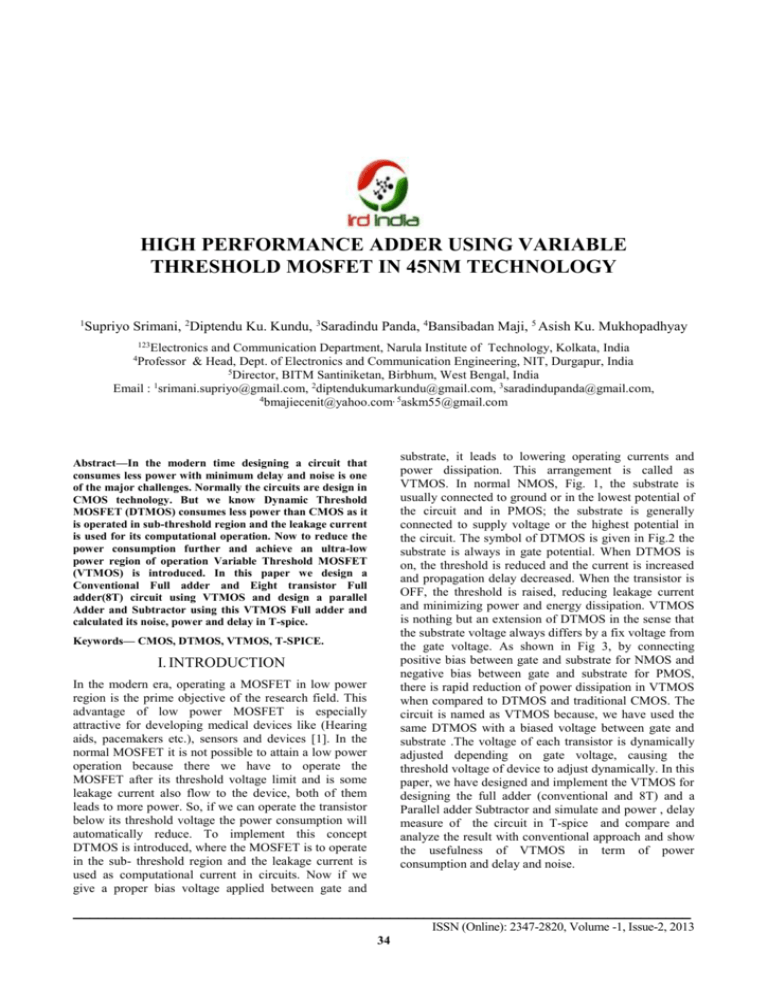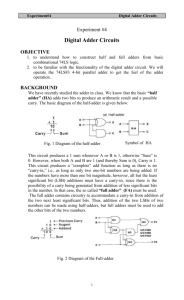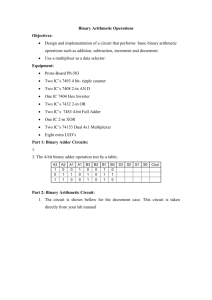IJEECS - IRD India
advertisement

International Journal of Electrical, Electronics and Computer Systems, (IJEECS) HIGH PERFORMANCE ADDER USING VARIABLE THRESHOLD MOSFET IN 45NM TECHNOLOGY 1 Supriyo Srimani, 2Diptendu Ku. Kundu, 3Saradindu Panda, 4Bansibadan Maji, 5 Asish Ku. Mukhopadhyay 123 Electronics and Communication Department, Narula Institute of Technology, Kolkata, India Professor & Head, Dept. of Electronics and Communication Engineering, NIT, Durgapur, India 5 Director, BITM Santiniketan, Birbhum, West Bengal, India 1 Email : srimani.supriyo@gmail.com, 2diptendukumarkundu@gmail.com, 3saradindupanda@gmail.com, 4 bmajiecenit@yahoo.com, 5askm55@gmail.com 4 substrate, it leads to lowering operating currents and power dissipation. This arrangement is called as VTMOS. In normal NMOS, Fig. 1, the substrate is usually connected to ground or in the lowest potential of the circuit and in PMOS; the substrate is generally connected to supply voltage or the highest potential in the circuit. The symbol of DTMOS is given in Fig.2 the substrate is always in gate potential. When DTMOS is on, the threshold is reduced and the current is increased and propagation delay decreased. When the transistor is OFF, the threshold is raised, reducing leakage current and minimizing power and energy dissipation. VTMOS is nothing but an extension of DTMOS in the sense that the substrate voltage always differs by a fix voltage from the gate voltage. As shown in Fig 3, by connecting positive bias between gate and substrate for NMOS and negative bias between gate and substrate for PMOS, there is rapid reduction of power dissipation in VTMOS when compared to DTMOS and traditional CMOS. The circuit is named as VTMOS because, we have used the same DTMOS with a biased voltage between gate and substrate .The voltage of each transistor is dynamically adjusted depending on gate voltage, causing the threshold voltage of device to adjust dynamically. In this paper, we have designed and implement the VTMOS for designing the full adder (conventional and 8T) and a Parallel adder Subtractor and simulate and power , delay measure of the circuit in T-spice and compare and analyze the result with conventional approach and show the usefulness of VTMOS in term of power consumption and delay and noise. Abstract—In the modern time designing a circuit that consumes less power with minimum delay and noise is one of the major challenges. Normally the circuits are design in CMOS technology. But we know Dynamic Threshold MOSFET (DTMOS) consumes less power than CMOS as it is operated in sub-threshold region and the leakage current is used for its computational operation. Now to reduce the power consumption further and achieve an ultra-low power region of operation Variable Threshold MOSFET (VTMOS) is introduced. In this paper we design a Conventional Full adder and Eight transistor Full adder(8T) circuit using VTMOS and design a parallel Adder and Subtractor using this VTMOS Full adder and calculated its noise, power and delay in T-spice. Keywords— CMOS, DTMOS, VTMOS, T-SPICE. I. INTRODUCTION In the modern era, operating a MOSFET in low power region is the prime objective of the research field. This advantage of low power MOSFET is especially attractive for developing medical devices like (Hearing aids, pacemakers etc.), sensors and devices [1]. In the normal MOSFET it is not possible to attain a low power operation because there we have to operate the MOSFET after its threshold voltage limit and is some leakage current also flow to the device, both of them leads to more power. So, if we can operate the transistor below its threshold voltage the power consumption will automatically reduce. To implement this concept DTMOS is introduced, where the MOSFET is to operate in the sub- threshold region and the leakage current is used as computational current in circuits. Now if we give a proper bias voltage applied between gate and __________________________________________________________________________ ISSN (Online): 2347-2820, Volume -1, Issue-2, 2013 34 International Journal of Electrical, Electronics and Computer Systems, (IJEECS) conducting channel. The output characteristic of PMOS transistor is shown in Fig.6. Fig.1. Structure of Conventional PMOS and NMOS Fig.4.Output characteristic of VTNMOS Fig.5. Input characteristic of VTNMOS Fig.2. Structure of DTPMOS and DTNMOS Fig.3. Structure of VTPMOS and VTNMOS II. CURRENT VOLTAGE (I-V) CHARACTERISTIC Fig.6. Output characteristic of VTPMOS III. VTMOS CIRCUIT TECHNIQUES For evaluating the I-V characteristics of NMOS devices under VTMOS operating condition, the I-V characteristics are measured and are given in Fig.4, To examine the effects of substrate bias on I-V output characteristics of NMOS under VTMOS operating condition, drain current Ids for different Vds voltages varying from 0 to 150mV and the output is shown in Fig 4.It may be seen that the variation in Ids with drain voltage,Vds becomes less as VIN is made positive (deep sub- threshold region).The input characteristic is also shown in Fig.5. Here, the conducting channel acts as a resistance and because of that the drain current I D is proportional to the drain-source voltage VDS.The characteristics may be flat, to indicate that the output resistance become very high. So, it gives the linear region or the Ohomic region of the characteristic. Thus the drain current is less sensitive to variations in drain voltages, which is a very useful feature for application of electronics device in circuits industry. In the case of PMOS for a given negative VGS, the drain voltage is made slightly negative with respect to the source. A current flows from the source to the drain through the The transistors for VTMOS logic are implemented in 45 nm technology. The threshold voltage for these devices is 150mV for VTNMOS and-150mV for VTPMOS. The Width of VTNMOS (WN) is chosen as 0.135µm and VTPMOS (WP) is chosen as 0.27µm. The supply voltage is taken as 0.1V which is below the threshold of both the devices. For different values the performance of the XOR gate is designed using VTMOS technique and power dissipation, propagation delay have been obtained through simulation it in T-Spice. When the bias voltage is increased beyond supply voltage, the logic levels are affected. Hence there is a limitation for bias voltage and it should be always below supply. A. XOR Operation The XOR gate is implemented by 3 transistors where the transistors are connected as in the fig.7.When the input B is at logic high, the inverter functions like a normal CMOS inverter. When the input B is at logic low, the CMOS inverter output is at high impedance. However, the pass transistor M3 is enabled and the output Y gets __________________________________________________________________________ ISSN (Online): 2347-2820, Volume -1, Issue-2, 2013 35 International Journal of Electrical, Electronics and Computer Systems, (IJEECS) the same logic value as input A. However, when A=1 and B=0, voltage degradation due to threshold drop occurs across pass transistor and consequently the output Y is degraded with respect to the input. Here the circuit diagram of XOR is given which is constructed by VTMOS and the output waveform is also given in Fig. 7. Fig.8. Circuit diagram of Conventional Full Adder using VTMOS Fig.7.Circuit diagram and Output of XOR (3T) B. Conventional Full Adder The following table shows the truth table of a binary full adder: TABLE-1 TRUTH TABLE OF FULLADDER CIRCUIT A B Ci S Co 0 0 0 0 0 0 0 1 1 0 0 1 0 1 0 0 1 1 0 1 1 0 0 1 0 1 0 1 0 1 1 1 0 0 1 1 1 1 1 1 Boolean expression for S and Co is given by the following equations: Fig.9. Output of Conventional Full Adder using VTMOS C. 8T Full Adder Structured approach for implementation of single bit full adder using XOR/XNOR has been shown in Figure 10. With decomposition of full adder cell into smaller cells, the equation becomes: Sum = H Cin = H. Cin+ H_bar. Cin Cout = A. H_bar+ Cin. H Where H is (A B) and H_bar is complement of H. s A B Ci ABCi ABCi ABCi ABCi C0 AB BC i ACi One way to implement the full-adder circuit is to take the logic equations above and to translate them directly into complementary CMOS circuitry. Some logic manipulations can help to reduce the transistor count. For instance, it is advantageous to share some logic between the sum- and carry-generation sub circuits. The following is an example of such a reorganized equation set: Fig.10. Block Diagram of Full Adder in XOR Blocks The exclusive–OR (XOR) and exclusive–NOR (XNOR) gates are the basic building blocks of a full adder circuit. The XOR/XNOR gates can be implemented using AND, OR, and NOT gates with high redundancy. Optimized design of these gates enhances the performance of VLSI systems as these gates are utilized as sub blocks in larger circuits. Here the XOR gates are implemented by previous mentioned 3T XOR Gate. To generate the carry output one 2:1 MUX is necessary where H is taken as control i.e. select line and two inputs are A and Cin. A design of an eight transistor (8T) full adder is shown in Figure. 11. C 0 AB ( B A)C i S ABCi C0 ( A B Ci ) The equivalence with the original equations is easily verified. The corresponding static CMOS is shown in the Fig 8 and requires 28 transistors. The output of Conventional Full Adder is given in Fig.9 __________________________________________________________________________ ISSN (Online): 2347-2820, Volume -1, Issue-2, 2013 36 International Journal of Electrical, Electronics and Computer Systems, (IJEECS) has been calculated with the given specification and given in Table II. From the table it is clear that 8T full adder with VTMOS consumes less power so, we have designed further a parallel adder subtractor circuit with the help of 8T full adder VTMOS and compare its noise power delay with the parallel adder subtractor circuit made with conventional CMOS. The output waveform of 8T full adder with VTMOS is given in Fig.14 and the output of parallel adder of bits(1111+1111) and (0001+0110) and the output of parallel subtractor(11110001) and (1010-0101) is also given in Fig.15. and Fig.16. Fig.11. Circuit diagram of 8T Full Adder using VTMOS D. Parallel Adder and Subtractor The 4bit parallel binary adder circuit performs both addition of two inputs A3A2A1A0 and B3B2B1B0. The augends (A3A2A1A0) and addend (B3B2B1B0) are added with CIN=0.Hence the circuit works as a 4-bit adder resulting in sum P3P2P1P0 and carry COUT. The 4bit subtractor performs subtraction of two inputs A 3A2A1A0 and B3B2B1B0.First the inverter produces the 1s complement of the addend (B3B2B1B0).Since 1 s given to Cin of the least significant bit of the adder, it is added to the complemented addend producing its 2’s complement of before addition. Then A3A2A1A0 will be added to the 2’s complement of B3B2B1B0 to produce the Difference. The circuit diagram of Parallel Adder and Parallel Subtractor is given in Fig.12 and Fig.13 respectively. Fig.14. Output of Full Adder using VTMOS Fig.15. Output of 4 Bit Parallel Adder using VTMOS Fig.12. Circuit diagram of 4 Bit Parallel Adder using VTMOS Fig.16. Output of 4 Bit Parallel Subtractor using VTMOS Fig.13. Circuit diagram of 4 Bit Parallel Subtractor using VTMOS Table-II NOISE POWER AND DELAY COMPARISION IV. RESULTS The conventional full adder and the conventional full adder with VTMOS is simulated in 45nm Technology moreover 8T Full Adder and 8T Full Adder with VTMOS is also simulated. The threshold voltage of NMOS in 45nm Technology 0.15V and for PMOS it is 0.15V.The Vdd is taken as 0.1V.The input voltage is taken as below the threshold voltage so the MOS are operated in sub-threshold region. The frequency of operation is taken as 1000 MHz. The noise power delay CONFIGERATION POWER (nW) NOISE (µV) DELAY (nSec) Conventional Full Adder Conventional Full Adder (VTMOS) 8T Full Adder 31 200 17 17 50 50 1.38 65 15 0.765 60 47 8T Full Adder(VTMOS) __________________________________________________________________________ ISSN (Online): 2347-2820, Volume -1, Issue-2, 2013 37 International Journal of Electrical, Electronics and Computer Systems, (IJEECS) CONFIGERATION POWER NOISE Parallel Adder with Conventional Full Adder 1.16µW 1.3MV Parallel Adder with 8T Full Adder (VTMOS) 3.2nW 45µV V. CONCLUSION VTMOS logic circuit techniques compared to CMOS circuits is extensively applied due to the low power consumption characteristic. From the result analysis we see, though it has little bit extra delay rather than normal CMOS or DTMOS, but it’s this disadvantage overcome by its extreme ultra low power region operating zone, which leads to cost effective circuit. If we build any complex circuit using this VTMOS approach, it will be more efficient and low cost. Fig.17. Power Consumption Comparison of Adders ACKNOWLEDGMENT The authors would like to thank Prof. (Dr.) M.R.Kanjilal and Faculty Members, Department of Electronics and Communication Engineering, Narula Institute of Technology, WBUT, for many insightful discussions. REFERENCES Fig.18. Delay Comparison of Adders Fig.19. Noise Comparison of Adders [1] K. Ragini, Dr. M. Satyam, And Dr. B.C. Jinaga “Variable Threshold Mosfet Approach (Through Dynamic Threshold Mosfet)For Universal Logic Gates”, International Journal Of Vlsi Design & Communicatio System (Vlsics) ,Vol.1 ,No.1, March 2010 [2] Fariborz Assaderaghi, Stephen Parke, Dennis Simitsky, Jeffrey Bokor, Ping K. Ko. Chenming Hu (1994):”A Dynamic Threshold Voltage Mosfet (Dtmos) For Very Low Voltage Opertaion” ,Ieee [3] Xiangli Li, Stephen A. Parke , And Bogdan M. Wilamowski, “Threshold Voltage Control For Deep Sub-Micrometer Fully Depleted Soi Mosfet”. [4] Fariborz Assaderaghi, Dennis Sinitsky, Stephen A. Parke,Jeffrey Bokor, Ping K. Ko, And Chenming Hu Dynamic Threshold-Voltage Mosfet (Dtmos) For Ultra-Low Voltage Vlsi, Ieee Transactions On Electron Devices, Vol. 44, No. 3, March 1997 TABLE-III NOISE AND DELAY COMPARISION OF APRALLEL ADDERS __________________________________________________________________________ ISSN (Online): 2347-2820, Volume -1, Issue-2, 2013 38




